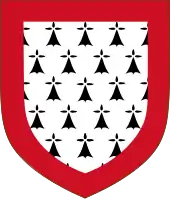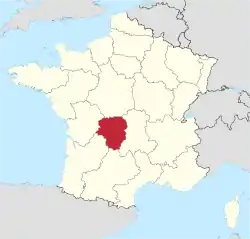Limousin
Limousin (French: [limuzɛ̃] (![]() listen); Occitan: Lemosin [lemuˈzi]) is a former administrative region of southwest-central France. On 1 January 2016, it became part of the new administrative region of Nouvelle-Aquitaine.[3] It comprised three departments: Corrèze, Creuse, and Haute-Vienne.
listen); Occitan: Lemosin [lemuˈzi]) is a former administrative region of southwest-central France. On 1 January 2016, it became part of the new administrative region of Nouvelle-Aquitaine.[3] It comprised three departments: Corrèze, Creuse, and Haute-Vienne.
Limousin
| |
|---|---|
 Flag  Coat of arms | |
 | |
| Coordinates: 45.68795°N 1.620483°E | |
| Country | |
| Dissolved | 2016-01-01 |
| Prefecture | Limoges |
| Departments | |
| Government | |
| • President | Gérard Vandenbroucke (PS) |
| Area INSEE | |
| • Total | 16,942 km2 (6,541 sq mi) |
| Population (2010-01-01)[1] | |
| • Total | 742,770 |
| • Density | 44/km2 (110/sq mi) |
| Time zone | UTC+01:00 (CET) |
| • Summer (DST) | UTC+02:00 (CEST) |
| ISO 3166 code | FR-L |
| GDP (2012)[2] | Ranked 21st |
| Total | €17.3 billion (US$24.2 bn) |
| Per capita | €24,354 (US$34,076) |
| NUTS Region | FR6 |
| Website | (in French)cr-limousin.fr |
Situated mostly in the west side of south-central French Massif Central, Limousin had (in 2010) 742,770 inhabitants[1] spread out on nearly 17,000 km2 (6,600 square miles), making it the least populated region of metropolitan France.
Forming part of the southwest of the country, Limousin is bordered by the regions of Centre-Val de Loire to the north, Auvergne to the east, Midi-Pyrénées to the south, Aquitaine to the southwest, and Poitou-Charentes to the west. Limousin is also part of the larger historical Occitania region.
Formation
The modern region of Limousin is essentially composed of two historical French provinces:
- Limousin: the department of Corrèze in its entirety and the central and southeastern part of Haute-Vienne. The entire old province of Limousin is contained within the modern Limousin.
- Marche: most of the department of Creuse and the north of Haute-Vienne. The old province of Marche is almost entirely contained within the modern region of Limousin, with only a small part of Marche now belonging to the region of Centre.
Beside these two main provinces, Limousin is also composed of small parts of other former provinces:
- Angoumois: extreme south-west of Haute-Vienne
- Poitou: extreme west of Haute-Vienne
- Auvergne: extreme east of Creuse
- Berry: extreme north of Creuse
Today the province of Limousin is the most populous part of the Limousin region. Limoges, the historical capital and largest city of the province of Limousin, is the capital of the Limousin administrative region.
Population
With a slowly rising population of just under 750,000, Limousin is the second-least populous region in Metropolitan France after Corsica.
The population of Limousin is aging and, until 1999, was declining. The department of Creuse has the oldest population of any in France. Between 1999 and 2004 the population of Limousin increased slightly, reversing a decline for the first time in decades.[4]
Major communities

Economy
Limousin is an essentially rural region. Famed for some of the best beef farming in the world, herds of Limousin cattle—a distinctive chestnut red—are a common sight in the region. The region is also a major timber producing area.
Due to its rural locality, it is also famed for its groves of French Oak, so prized for its distinct characters and flavors in wine fermentation that vintner Rémy Martin has exclusive rights to its oak groves. It is a partnership that is over 100 years old.
The regional capital, Limoges, was once an industrial power base, world-renowned for its porcelain and still a leader and innovator in electric equipment factories (which originally used porcelain as an insulator). However, large factories are now few in number. Limousin is the poorest region in Metropolitan France; only the overseas collectivities have a lower GDP per capita.
Geography and climate
Bodies of water
Some of the rivers belonging to the Loire basin run through the north, west and east of the region, waterways belonging to that of the Dordogne through the south. The region is crossed by three major rivers: the Vienne, the Dordogne and the Charente (which has its source in Haute-Vienne). The region is well known for the high quality of its water and for offering first-rate fishing.

Topography
The Limousin region is almost entirely an upland area. The lowest land is in the northwest of the region (approximately 250 m or 800 feet above sea level) and the highest land is roughly in the southeast (approximately 1,000 m or 3,300 feet above sea level). However, the greater part of the region is above 350 m or 1,150 feet.
History

Limousin is one of the traditional provinces of France. Its name derives from that of a Celtic tribe, the Lemovices, who had their capital at Saint-Denis-des-Murs and whose main sanctuary was recently found in Tintignac, a site which became a major site for Celtic studies thanks to unique objects which were found - such as the carnyces, unique in the whole Celtic world.[5]
Viscount Aimar V of Limoges (c. 1135 – c. 1199) was a notable ruler of the region.
Culture

Language
Until the 1970s, Occitan was the primary language of rural areas. There remain several different Occitan dialects in use in Limousin, although their use is rapidly declining. These are:
- Limousin (Occitan: Lemosin) dialect
- Auvergnat (Occitan: Auvernhat) dialect in the East/North-East
- Languedocien (Occitan: Lengadocian) in the Southern fringe of Corrèze
- in the North, the Crescent transition area between Occitan and French is sometimes considered as a separate (basically Occitan) dialect called Marchois (Occitan: Marchés).
Cuisine
Pâté aux pommes de terre is one of the specialties of Limousin, as well as of the neighbouring department of Allier. Clafoutis is a local dessert.
Music
Perhaps due to its rural character, Limousin has maintained a strong tradition of traditional music, with ancient instruments such as the bagpipe (called chabrette, Chabreta in occitan) and hurdy-gurdy remaining popular.
- Festival 1001 Notes, music festival in Haute-Vienne, August
- Festival de La Vezere, music festival in Corrèze July–August
- Festival du Haut Limousin, music festival in Haute-Vienne, July–August
- La Borie en Limousin, foundation of music in Haute-Vienne
Transportation
- The word limousine is derived from the name of the region. A particular type of carriage hood or roof physically resembled the raised hood of the cloak worn by the shepherds there.
Notable residents
From Corrèze
From Creuse
From Haute-Vienne
See also
- Limousin (cattle), a breed of beef cattle bred in the Limousin region and recognisable by their chestnut red coloring.
- Limousin (dialect), the Occitan dialect of the region.
- TER Limousin
Footnotes
- INSEE, 2010 census results
- INSEE. "Produits intérieurs bruts régionaux et valeurs ajoutées régionales de 1990 à 2012". Retrieved 2014-03-04.
- Loi n° 2015-29 du 16 janvier 2015 relative à la délimitation des régions, aux élections régionales et départementales et modifiant le calendrier électoral (in French)
- Yann Leurs, Recensement : rebond démographique confirmé, INSEE, 2006, see online
- http://tintignac.wix.com/tintignac-naves#!english/c11e3 Official website of Tintignac-Naves
External links
- Limousin : the “château d'eau” - Official French website (in English)
- (in French) Limousin regional council website, with a presentation video in English.
- (in French) Art in the Limousin region
- (in French) History and Geography (University of Limoges)
